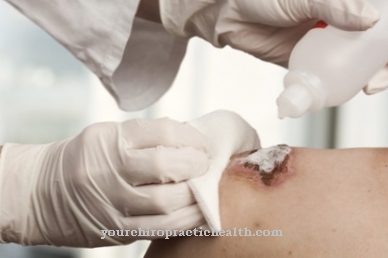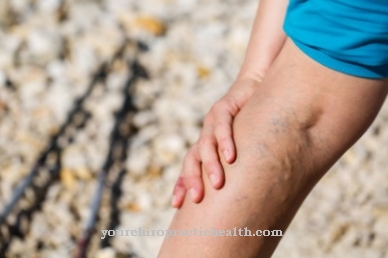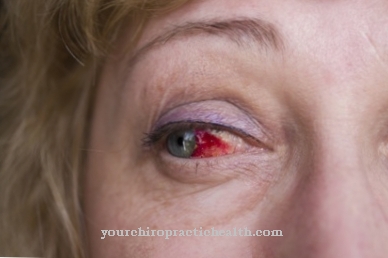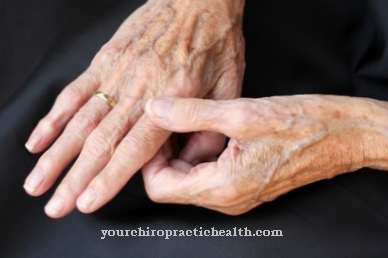At paleness a person's complexion appears paler than usual. Possible causes of paleness are low blood pressure, anemia, and leukemia. The treatment depends on the underlying disease and can be omitted for harmless causes.
What is paleness?

Pallor is a phenomenon in which a person's skin color is lighter than normal. It should be noted that every person has an individual skin color. This means that some people naturally have particularly fair skin.
With a light skin color alone, there is no paleness, because paleness means that the skin is lighter than usual. People from the north or people who are rarely in the sun due to their lifestyle typically have a rather pale skin color.
Basically, pallor as a symptom should be taken seriously as it can indicate an underlying medical condition. In most cases, the face is pale and the skin on the face or neck appears paler than normal. However, a change in the normal skin color can also occur in other areas of the skin.
causes
There are various causes for paleness. Often there is a noticeable paleness of the face with circulatory disorders. This occurs particularly frequently with low blood pressure, as it can sometimes lead to problems with blood circulation.
A spontaneous circulatory weakness usually passes quickly and often has no serious cause. If the paleness persists over a long period of time, there may be anemia, i.e. a deficiency in the red blood pigment. Characteristically, with anemia, the pallor is also visible on the mucous membranes. Pale skin can also indicate a lack of minerals or vitamins.
If, for example, the body does not get enough folic acid (vitamin B12), this deficiency can become noticeable as pale skin color. Also, pallor can indicate a serious condition such as cancer. In leukemia, for example, there is a shortage of red blood cells, which means that affected people usually have a very pale skin color.
Other possible causes of pallor are heart disease, diabetes, cirrhosis of the liver, kidney failure and a wide variety of circulatory disorders.
You can find your medication here
➔ Medicines for pale skinDiseases with this symptom
- Infectious diseases
- Mineral deficiency
- Anemia
- leukemia
- Metabolic disorder
- Pheochromocytoma
- Low blood pressure
- Cirrhosis of the liver
- Folic acid deficiency
- Circulatory disorders
- Hypothermia
- Splenomegaly
- Acute stress reaction
- Diabetes mellitus
- Renal failure
- Vitamin deficiency
- Heart disease
- Pseudo croup
Diagnosis & course
Pallor in and of itself is not a disease; it is just a symptom of an underlying disease. Since there are many possible causes of paleness, it is important that the treating doctor take a detailed medical history.
This is followed by a basic examination of the body functions. Among other things, the doctor measures the blood pressure and examines the oral mucosa. Depending on the suspected diagnosis, he will then order further tests such as an EKG or a bone marrow examination. If the doctor suspects a vitamin or mineral deficiency, the diagnosis can be confirmed by a blood test.
During the blood test, the liver and kidney values are also measured to determine the functionality of the organs. The course of pallor depends on the underlying disease. If it is only a minor case of low blood pressure, the prognosis is extremely positive. Serious illnesses such as leukemia can sometimes be life-threatening.
Complications
Pallor can be completely normal and healthy depending on the skin type, which is why it is sometimes not recognized as a symptom of the disease. The lighter the skin type, the less paleness would be noticed and can be overlooked for a long time. In everyday life, paleness becomes difficult, especially in summer, because pale skin has lower levels of the skin pigment melanin. This not only tones the skin darker, it also protects it from the harmful components of sunlight.
Sunburn can therefore occur more easily; if you are very pale, a few minutes in the blazing sun are sufficient. Due to the tendency to sunburn, the skin is more severely attacked even by low UV light exposure and skin cancer is more likely to develop in old age, as the skin has to constantly regenerate and recover from burns. If you are very pale, a normal sun cream is no longer sufficient and it is also not enough to only use it when necessary.
To avoid skin cancer from years of exposure to the sun, sun protection with a high SPF must be worn regularly. Visits to the solarium are particularly dangerous, because if you are pale, the light attacks sensitive skin just like natural sunlight and even very good sun protection may not be enough to completely ward off damage to pale skin.
When should you go to the doctor?
Pallor is not necessarily a symptom of illness. Some people naturally have particularly fair skin. It wasn't that long ago that pale skin was even considered elegant. People who are paleness are often given special attention, with others worrying that they may not be well. Pallor from childhood is no reason to see a doctor, especially if the person is doing well. A little make-up and blush help to liven up the complexion and attract less attention in the future because of paleness.
However, if paleness has only appeared for some time, possibly with fatigue and a lack of appetite, it is better to consult your family doctor. Frequent causes of paleness can be iron deficiency with the resulting anemia as well as low blood pressure, poor circulation or heart disease. An abnormal paleness can also be due to kidney inflammation, liver disease, spleen disease, rheumatism or blood cancer.
The family doctor, who has usually known his patient for a while, will be able to assess the situation well. Based on his anamnesis and initial examinations, he will refer to a specialist colleague if necessary, such as an internist, cardiologist, hepatologist, rheumatologist or oncologist.
Doctors & therapists in your area
Treatment & Therapy
In order to be able to treat pallor effectively, a diagnosis must first be made, because the therapy depends on the underlying disease.
If the patient suffers from a slight circulatory weakness, this usually does not require treatment. In the event of a vitamin or mineral deficiency, it is often sufficient to change your diet. A vitamin B12 deficiency can usually be treated very well with an appropriate diet. This also applies to iron deficiency, which can also lead to paleness. If the iron deficiency is severe, however, iron transfusions must be given to replenish the iron stores in the body.
If the change in diet does not bring the desired success in the event of a vitamin deficiency, the substances concerned can also be supplied in the form of dietary supplements. This is particularly important during pregnancy in order not to endanger the child's development.
If you have severe circulatory problems and fainting, you may need to take blood pressure medication. A circulatory disorder of the skin caused by smoking usually does not require medical treatment, as the blood circulation improves as soon as the person concerned quits smoking. If this does not succeed, it may be necessary to give up smoking with medical supervision.
Cancer therapy must be tailored to the patient's individual clinical picture.
Outlook & forecast
A pallor does not necessarily have to be a disease. Many people are pale due to their origins, which is not a health limitation. If the pallor is not due to an illness, it does not need treatment. However, it is possible to tint the skin color darker and thus change it through exposure to the sun or in the solarium.
However, pallor can also occur due to poor health. In this case, the affected person's complexion is very different from the usual complexion. The paleness occurs mainly with colds, flu and other infections and is not that bad. It usually disappears after a few hours and does not need further treatment if it is only temporary.
If the paleness of the face persists and has nothing to do with an acutely changed state of health, a doctor must be consulted. In this case, the pallor is related to another symptom.
In most cases, the symptom of paleness does not have to be targeted, as it disappears on its own and is only a sign of a temporarily poor state of health. On the other hand, it is helpful to treat the cause of the pallor.
You can find your medication here
➔ Medicines for pale skinprevention
Acutely occurring pallor as a result of low blood pressure or fainting is difficult to prevent.If the occasional circulatory weakness is already known, precautionary measures can be taken.
So it is advisable not to go out of the house without breakfast and to ensure a balanced diet during the day. If there is an increased need for vitamins or minerals, these should also be taken. This is especially true for pregnant women.
Serious diseases like leukemia cannot be prevented. In order to detect a possible cancer at an early stage, preventive examinations should be carried out at regular intervals.
You can do that yourself
Paleness often has harmless causes and can be effectively treated with personal measures and various home remedies. First of all, it is advisable to spend a lot of time in the fresh air and, if possible, to exercise regularly. In general, paleness can at least be reduced with enough sunlight and a balanced diet, although a light skin type is mostly genetic.
Eating carrots and other foods high in beta-carotene, grape juice, paprika, or beetroot is also an effective measure to combat paleness on the face. In addition, a sufficient intake of vitamins and minerals such as iron should be ensured. Alternating showers are also considered helpful for pale skin and ensure a rosier coloration of the skin. In addition, various home remedies help: a face mask with apples, cucumber or honey promotes blood circulation in the face, as do massages or a hot bath.
In the long run, paleness can be reduced with a healthy lifestyle and spending time in the sun. However, if there is a serious underlying condition, it should be treated first. Once the underlying disease has been overcome, the paleness usually disappears.
























.jpg)



